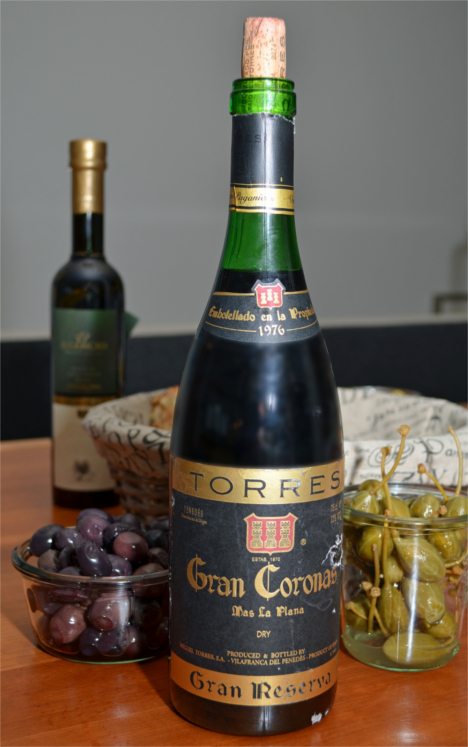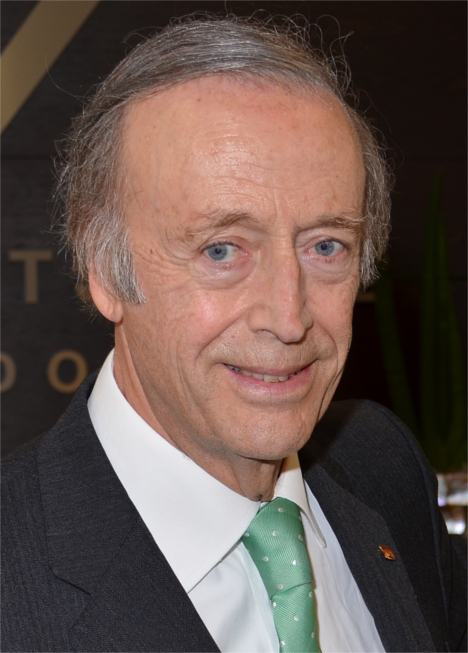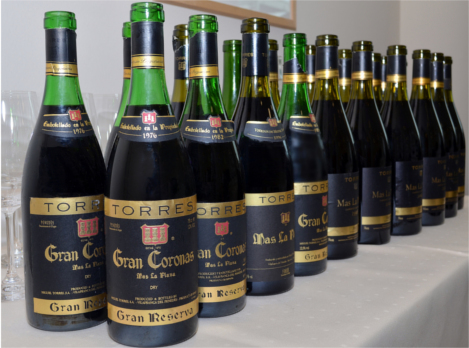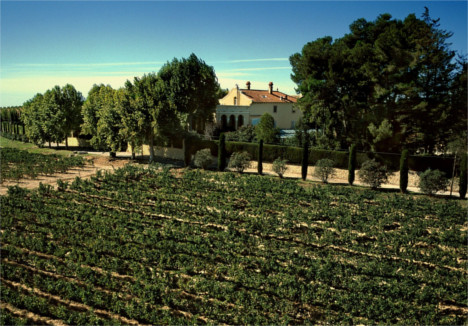In 1979, at the prestigious Gault Millau "Wine Olympics" in Paris, a Spanish Cabernet Sauvignon beat its great competitors. Among them were top châteaux like Latour and Lafite. In the blind tasting, only French experts and wine journalists had tasted - and there, an unknown Spanish wine with the unknown name "Gran Coronas Black Label" wins the first prize. The wine had also been filled into a Burgundy bottle with a black label. That was also quite unusual at the time. It was produced by 29-year-old Miguel A. Torres. This put Spain on the map of great red wines for the first time. The young winegrowing pioneer Torres had studied in Dijon, France, and even that was considered a betrayal by Spanish winemakers. He comes from the Pénedes region near Barcelona, where in the 1960s only grapes for Cava were produced. Nobody knew Cabernet, how to produce it was unknown. And now the most famous red wine in Spain came from the heart of this growing region.
 |
| Gran Coronas Black Label (Photo: Kauss) |
It was only a few years later that Miguel Torres had the name of his vineyard in Pénedes printed on the label: Mas La Plana. He had planted Cabernet Sauvignon there in the 1960s after long discussions with his father. The neighbours shook their heads. "Many thought I was crazy when I started. 'Why is he doing this?' everyone wondered. There were many discussions with my father. He wasn't sure if it would be right either. But he allowed it." The two didn't know what to expect: At the time, we had no idea about the terroir and the climates in the vineyard. But we were determined to do it." It was a time that is hard to imagine today: "The winegrowers treated red wine vines like Cava grapes, because Cava production was their only source of income at the time. So they produced large quantities with a lot of acid. But I didn't want that anymore. I had previously worked with Cabernet in California and in France. I knew what should be possible with it here."
 |
| Miguel Torres (Image: Kauss) |
Tasting ten Mas La Plana vintages in Düsseldorf, the now 73-year-old wine pioneer recalls, "One morning I got an excited call from Paris: 'Monsieur Torres, you won the Olympics!' I beg your pardon? What's it all about, I asked back. And the importer explained it to me in a trembling voice." Torres, who speaks fluent French, laughs and his eyes flash as if the call came yesterday. The wine had entered the "Cabernet Sauvignon Cuvées" category. The importer had organised the participation. "I wasn't there myself, I didn't even know we were taking part. It was a young Cabernet with some Tempranillo and Cabernet Franc. And then such a victory." Torres beams and adds quietly: "I would never have expected that. Maybe there was also a bit of luck involved." But suddenly the name Torres was in the wine magazines of the world and in the lifestyle magazines of the time. Shortly afterwards, everything changed in the fast-growing family business.
 |
| Gran Coronas Black Label (Photo: Kauss) |
For Miguel Torres, the 150 to 200-metre-high Mas La Plana vineyard of clay, chalk and limestone, facing east and southeast, has yet another significance in the history of today's wine empire. "Mas La Plana is the first vineyard with which my family started producing wine again after the Second World War. We lost all our land in the Spanish Civil War, only the vineyard was left. In the 1950s, my father bought this land and I planted it after graduating. At its foot is the finca where I live. This vineyard is my life." His role model was his close friend Jean Leon, whose vineyard passed to Torres after his death. Leon, who was of Italian descent, lived in the USA and had great success with luxury restaurants. His friends included Hollywood stars, top celebrities like Frank Sinatra, Sammy Davis Jr. and politicians like the Kennedy family. In 1964, he established his winery near the Torres vineyards - and planted Cabernet. He didn't care about the Spanish tradition of grape varieties. Americans loved wine from this variety, and he grew it.
 |
| Mas La Plana (Photo: Kauss) |
In the early years, the production volume of Mas La Plana was around 50 to 55hl per ha, today it is much less, Miguel Torres tells us. "The wine also had a little less colour because of that." It was not until 1981 that he had the wine produced one hundred percent from Cabernet Sauvignon, because the base wines had turned out better and better. "We concentrated more by bringing in much less quantity. We experimented a lot without changing the wine and its naturalness." Today, only the best parcels of the vineyard are used for Mas La Plana, plus ten per cent grapes from areas with vines at least 35 years old very close by. The second wine produced from the remaining areas in the vineyard also has a very good name and is known almost all over the wine world: Gran Coronas.
Robert Parker also came to the winery to taste it after the win in Paris. "Through his influence, we gave the wine more colour, more structure and more depth," explains Miguel Torres. "In 90s we made big steps forward because we worked very intensively on the use of barrique. I wasn't satisfied with that at the time." In the 70s and 80s, it was almost impossible to get very good barrique barrels: "The cellars only gave their best barrels to companies in France. Today, we use 100 per cent new barriques only from French producers in every vintage. That way, the wine develops a good structure." How times change: "For some years now, we have been inviting a number of wine cellars to a competition to find out which barriques are best suited for each new vintage. We buy a large number of barrels from the best supplier, and we also pay them large advertisements in the Spanish wine magazines."
Miguel Torres looks at the filled wine like a scientist. "I like the old and the new style of Mas La Plana. The current 2010 vintage comes from vines that are around 50 years old. Maybe these bottles won't taste as good in 38 years as the 1976 with only 12 per cent alcohol, which is currently quite wonderful to drink. But these vintages took at least five years to at least open." 40 years of Mas La Plana are 40 years of Spanish winemaking history. You can taste it. In the old and in the young vintages.